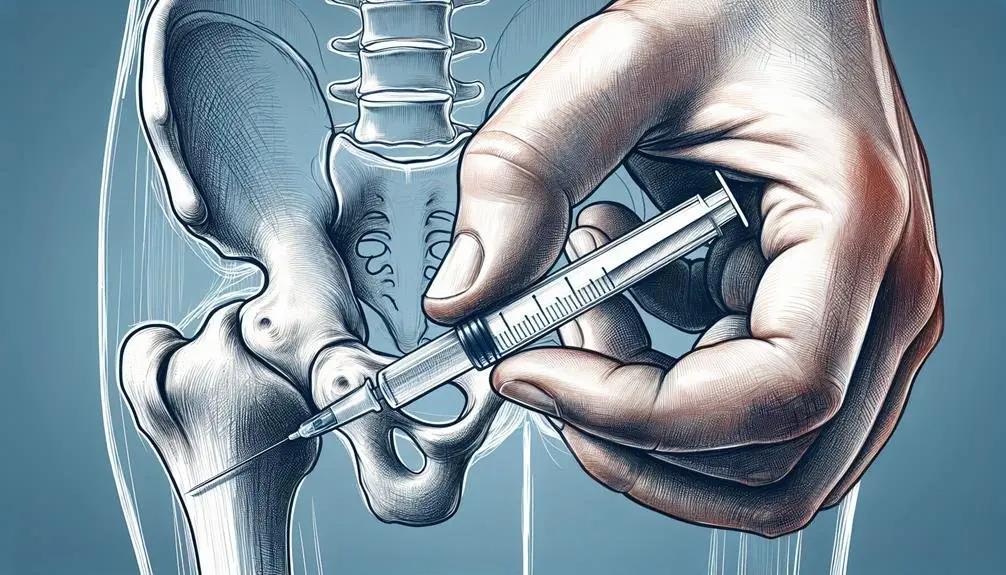
To understand and overcome sacroiliac joint pain, you should consider causes like trauma, pregnancy, and muscle imbalance. Prevention involves exercises like yoga, ergonomic changes, and proper sleeping positions. Symptoms include lower back or buttock pain, worsened by standing. Diagnosis requires tests and imaging. Treatment spans therapy to surgery. Lifestyle changes, physical therapy, surgery, and self-care can all aid in managing and relieving this pain, empowering you to take charge of your health and well-being.
Key Takeaways
- Engage in targeted exercises like yoga and pilates for strength and flexibility.
- Implement ergonomic furniture and proper posture for pain prevention.
- Seek professional guidance for tailored treatment strategies.
- Explore alternative therapies such as acupuncture for relief.
- Practice mindfulness, relaxation, and stress management techniques for holistic well-being.
Causes of Sacroiliac Joint Pain

When exploring the causes of sacroiliac joint pain, it is imperative to understand the various factors that can trigger discomfort in this pivotal joint. Risk factors for sacroiliac joint pain include trauma from accidents, pregnancy-related weight gain, hormonal changes, ligament elasticity issues, muscle imbalance due to prolonged sitting or standing, and arthritis affecting the joint over time. These factors can impact your mobility significantly, manifesting as a sharp or dull pain in the lower back or buttocks that may radiate down one leg, particularly aggravated by standing after prolonged sitting or taking significant strides while walking. Even sleeping on the affected side can worsen the pain.
Prevention strategies play a vital role in addressing sacroiliac joint pain. Incorporating targeted exercises like yoga and pilates into your routine can enhance flexibility and core strength, stabilizing the joint and reducing discomfort. Lifestyle adjustments such as using ergonomic furniture to support proper posture during prolonged sitting and ensuring your sleeping position doesn’t exacerbate pain can also make a substantial difference. If these measures are insufficient, seeking professional help is essential. Treatment options range from physical therapy for relief strategies to more advanced interventions like injections or surgery for severe cases. By understanding these causes and implementing appropriate measures, you can effectively manage sacroiliac joint pain and regain control over your mobility and comfort.
Symptoms and Diagnosis
Exploring the symptoms and diagnostic methods for sacroiliac joint pain provides vital insights into effectively identifying and managing this debilitating condition. When it comes to pain management, understanding the unique symptoms of sacroiliac joint (SIJ) pain is essential. Symptoms often include sharp or dull lower back or buttocks pain that may radiate down one leg. This discomfort is typically worsened by standing after prolonged sitting, taking long strides while walking, or sleeping on the affected side.
The diagnostic process for SIJ pain involves a thorough examination by a healthcare provider. This may include physical tests to pinpoint the source of pain, imaging studies like X-rays or MRI scans to visualize the joint, and diagnostic injections to confirm the SIJ as the pain generator. Once a diagnosis is established, various treatment options can be explored, ranging from conservative measures like rehabilitation exercises to more invasive interventions like injections or surgery.
Rehabilitation exercises play a vital role in long-term care for SIJ pain. Targeted exercises such as yoga and pilates can help increase flexibility and core strength, stabilizing the joint and reducing discomfort. Additionally, lifestyle modifications, such as ergonomic adjustments and proper posture support, are essential in managing SIJ pain effectively. Seeking professional guidance when needed ensures tailored care strategies for individual needs, promoting a successful journey toward recovery and pain relief.
Lifestyle Modifications for Relief

To effectively manage sacroiliac joint pain, implementing specific lifestyle modifications can be essential in providing relief and promoting long-term recovery. Individuals can take significant strides towards alleviating their discomfort and enhancing their overall well-being by incorporating targeted exercise routines and dietary changes, nurturing the mind-body connection, exploring alternative therapies, and mastering stress management techniques.
| Lifestyle Modification | Description |
|---|---|
| Exercise routines | Integrate gentle activities like yoga and pilates to increase flexibility and core strength. |
| Dietary changes | Adopting a balanced diet rich in anti-inflammatory foods can help reduce joint inflammation. |
| Mind-body connection | Practicing mindfulness and relaxation techniques can aid in managing pain and reducing stress. |
| Alternative therapies | Explore options such as acupuncture or chiropractic care to complement traditional treatments. |
| Stress management | Implement stress-reducing activities like meditation or deep breathing to alleviate tension. |
Physical Therapy Techniques
Implementing physical therapy techniques is vital in addressing sacroiliac joint pain effectively and promoting the best recovery outcomes. When dealing with sacroiliac joint pain, incorporating the following strategies can be advantageous:
- Strengthening exercises: Targeted exercises focusing on the muscles surrounding the sacroiliac joint can help stabilize it and reduce discomfort.
- Core stability: Improving core strength is essential for supporting the lower back and pelvis and reducing strain on the sacroiliac joint.
- Flexibility training: Engaging in yoga and pilates can enhance flexibility, which is vital for maintaining proper joint function and mobility.
- Pain management: Utilizing specific pain relief strategies as part of physical therapy can help alleviate discomfort and improve overall quality of life.
- Movement therapy: Incorporating movement-based therapies can help restore proper alignment, improve range of motion, and promote healing within the sacroiliac joint.
Medications and Injections

When addressing sacroiliac joint pain, medications and injections are commonly used to manage symptoms and relieve symptoms. Pain management is essential in alleviating discomfort associated with sacroiliac joint issues. Medication options such as nonsteroidal anti-inflammatory drugs (NSAIDs), muscle relaxants, or corticosteroids may be prescribed to reduce inflammation and alleviate pain. In cases where oral medications are not sufficient, injection therapy can be considered. Injection therapy involves delivering medications directly into the sacroiliac joint to target pain and inflammation more effectively.
Alternative treatments like acupuncture or chiropractic care may also be explored to complement traditional medication approaches. Working closely with healthcare providers to determine the most suitable treatment plan for your specific condition is essential. Throughout the recovery process, monitoring the effectiveness of medications and injections is crucial to adjust the treatment plan as needed. It is important to note that while drugs and injections can provide temporary relief, they are often part of a complete treatment approach that may include physical therapy, lifestyle adjustments, and other interventions tailored to address sacroiliac joint pain effectively. By actively participating in your treatment plan and collaborating with healthcare professionals, you can optimize your journey toward managing sacroiliac joint pain and improving your quality of life.
Surgical Interventions
Upon exhausting non-surgical options for managing sacroiliac joint pain, surgical interventions may be considered to address the underlying issues and provide long-term relief. When opting for surgical interventions, there are essential aspects to take into account:
- Recovery options: After surgery, you will be provided with detailed guidelines on promoting healing and regaining strength. This may involve specific exercises, restrictions on certain activities, and follow-up appointments to monitor progress.
- Surgical advancements: Modern surgical techniques, such as minimally invasive procedures, have greatly improved outcomes for sacroiliac joint surgeries, leading to reduced pain and quicker recovery times.
- Rehabilitation process: Following surgery, a structured rehabilitation program will be essential to enhance mobility, build strength, and prevent complications. Physical therapy sessions may be recommended to aid in your recovery.
- Long-term outcomes: Surgical interventions aim to provide lasting relief from sacroiliac joint pain, allowing you to resume your daily activities without the previous limitations and discomfort.
- Postoperative care: It is important to diligently follow postoperative care instructions, including wound care, medication management, and attending scheduled follow-up appointments, to ensure ideal healing and long-term success.
Self-Care Practices and Prevention

Incorporating self-care practices into your daily routine is essential to manage and prevent sacroiliac joint pain effectively. Self-care routines play an important role in maintaining the health of your sacroiliac joint. Prevention strategies, such as targeted exercises like yoga and pilates, can help increase flexibility and core strength without overburdening the joint. These gentle activities aid in stabilizing the muscles surrounding the sacroiliac joint, reducing discomfort and preventing future issues. By fostering a strong mind-body connection through holistic approaches like mindfulness and relaxation techniques, you can alleviate stress and tension that may contribute to sacroiliac joint pain. Additionally, adopting wellness habits, such as maintaining proper posture with ergonomic furniture and ensuring your sleeping position supports your joint health, can make a significant difference in managing and preventing discomfort.
Recognizing the importance of self-care practices and prevention strategies is paramount in overcoming sacroiliac joint pain. By integrating these holistic approaches into your daily life, you can empower yourself to take control of your well-being and work towards a pain-free existence. Remember, a proactive approach to self-care and prevention is critical to managing sacroiliac joint pain effectively and improving overall quality of life.
Frequently Asked Questions
Are There Any Specific Dietary Recommendations or Supplements That Can Help Alleviate Sacroiliac Joint Pain?
When dealing with sacroiliac joint pain, conservatory diets, nutritional supplements, and natural remedies like turmeric can aid in pain management. Consulting a healthcare provider for tailored dietary modifications is essential for relief.
Can Emotional or Psychological Factors Contribute to the Development or Exacerbation of Sacroiliac Joint Pain?
Emotional triggers like stress can contribute to sacroiliac joint pain. Understanding the mind-body connection is essential. Coping strategies, stress management, and psychological support play critical roles in addressing and potentially alleviating the development or exacerbation of SI joint pain.
Are Any Alternative Therapies or Complementary Treatments Effective in Managing Sacroiliac Joint Pain?
In managing sacroiliac joint pain, consider acupuncture, yoga, massage, chiropractic care, heat/cold therapy, mind-body techniques, meditation, physical therapy, and herbal remedies. These complementary treatments offer diverse approaches to alleviate discomfort and enhance your well-being effectively.
How Do Weather or Seasonal Changes Impact Sacroiliac Joint Pain, and Are There Any Strategies to Manage These Fluctuations?
Incorporating lifestyle modifications is critical when managing sacroiliac joint pain and weather impact. Recognizing weather-related flare-ups and adopting prevention techniques like staying warm, practicing self-care tips, and adjusting activities can help alleviate discomfort.
Are Any Specific Exercises or Activities That Should Be Avoided to Prevent Worsening Sacroiliac Joint Pain?
To prevent worsening sacroiliac joint pain, avoid high-impact exercises like running and activities that strain the lower back. Instead, focus on gentle exercise modifications like yoga, lifestyle adjustments, proper posture correction, identifying pain triggers, and seeking guidance from physical therapy.
